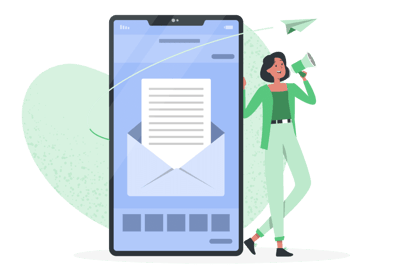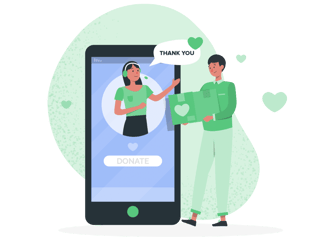Welcoming new donors is an important part of a successful fundraising strategy and a key moment that can make or break your relationship.
What is the best way to welcome new donors in order to ensure a strong, long-lasting relationship?
Welcoming a new donor is a significant step in the donor journey that can make or break your relationship. “You won’t get a second chance to make a good first impression,” as a famous fashion designer once said. Well, the same goes for online fundraising!

Let’s put ourselves in the donor’s shoes for a few minutes: he doesn’t really know you and yet he is entrusting you with a sum of money that he hopes you will put to good use, a gift for which he himself will receive nothing tangible in return.
The least you can do is say thank you, right? And yet, when you look at the subject line of emails sent immediately after a donation, the word thank you does not appear in the vast majority of cases. Instead, the words “Donation confirmation” are used, rather cold as a welcome message, don’t you think?
Make sure to use the word “Thank you” in the subject line of your email design. Better yet, say “Thank you John” or “Thank you Mr. Smith”, depending on your communication style and email templates, to immediately personalize the first interaction with your donor.
For the remainder of the email, be consistent and make it personal. Do not hesitate to use personalization on all levels, it will help you in building trust and make your open rates higher:

- Send a welcome email, and remember, the greeting should be warm and include their name: “Dear John”
- When referring to the amount donated: “A special thank you..” or ”We are extremely grateful for the donation of €70 you just made to our organisation.”
- When referring to the campaign they donated to (when the campaign is identified of course): “Thanks to your generosity, we will be able to provide immediate relief to the people affected by the recent earthquake in Nepal!”
- Personalize the signature of your email: Rather than simply signing “Donor Service”, or with an unlikely “President”, make it as relatable and warm as possible. Sign your email on behalf of “Nathalie, from Donor Service”, and, even better, add Nathalie’s photo and her direct number to make donors feel even more well taken care of!

Of course, don’t forget to also mention their tax receipt: when and how they are able to access it.
For major gifts, first-time donors, the same email sent to standard donors should not be sent. Instead, it would be best to schedule a call, either from the donor department or from the director or president themselves, to thank the major donor personally. A thank you letter, signed by the President, is also a nice touch.
 And how quickly after the donation should you send a thank you email? Immediately. It may be obvious to some, but instant gratitude prevails in the digital world. Thanking your donor 3 days later is completely out of the question.
And how quickly after the donation should you send a thank you email? Immediately. It may be obvious to some, but instant gratitude prevails in the digital world. Thanking your donor 3 days later is completely out of the question.
And now, what’s next ? As you may have caught on, welcoming a new donor is not limited to just sending a thank-you email or phone call.
The welcome phase is a very important, dedicated stage in the donor’s journey: it is called the “welcome journey”.

Here is are some examples of what you may want to include:
Presentation emails
- A video presentation of your association: your headquarters, your team, etc.
- A video describing your organisation’s mission
- An explanation ofn how donors can access their account or donor space (if available online)
- A welcome email from a representative in your donor department, explaining in which occasions they may be contacted by your team.
Call to Action emails
- An invitation to an open house at your organiszation (if you are organizing one) or an event
- An email containing a questionnaire to find out what their preferences are: how often they prefer to be contacted, with what type of information, on what subjects, etc
- A short questionnaire asking if he or she would be willing to recommend your nonprofit.
- A reminder or request to follow your nonprofit on social media
- A petition to sign
- An email from a volunteer proposing to join him/her
Reassurance Emails
- An email with testimonials from beneficiaries
- An email regarding the association’s operations (fundraising / strategy / mission ratio)
And finally a newsletter to close the cycle.
It is up to you to make the appropriate choice from the list above according to your abilities and of course drawing on your strengths. If your strength is your network, for example, then an email describing this network should be sent.
On average, the welcome cycle for a new donor must be completed in 30 days: 30 days in which no additional donation is requested, but during which the donor is informed, the organisation shows interest in their new donor, and reassures them they made the right choice to donate to this particular mission.
Remember that it is also important to allocate some time and budget to “paper” communications. Even though you may have acquired your new donor on a digital channel, we find that a relationship often lasts longer when the donor is contacted at least 2-3 times a year through print media. This can be done, for example, by sending a welcome booklet.

Finally, one last piece of advice. If your new donor comes from a Peer to peer campaign, keep in mind that the typology of this donor is different than that of a traditional donor.
Above all, he will have made a donation on your peer to peer fundraising platform to support his friend/acquaintance, but not to support your organisation, which he probably is not familiar with. Keeping this in mind, you will therefore have to adapt the relationship journey.
The use of a marketing automation tool will certainly make your life easier when it comes to managing your donor journey.
Would you like to know more about how to communicate with your donors? Read iRaiser's article on the subject: Tax Receipts & Thank You Letters: A fundraising opportunity!
